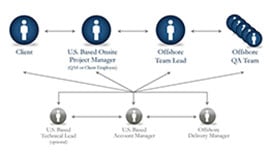For all our metrics, test plans, Agile approaches, and strict industry standards, the end goal of every software development project is the same: happy customers. The user experience is our definition of success.
QASource Blog
In our blog, we take a deep dive into the latest QA strategies, methodologies, and industry best practices driving the world of quality assurance. Follow our blog to get new ideas as to how to effectively deliver high-quality, bug-free software products, websites, and applications, while keeping costs low.

A healthy QA culture results in strong, confident teams. And with a powerful team in place, you can produce exceptional products and achieve greater success when going to the market. While the task of building great culture belongs to the QA Team Manager, it’s up to each member of your software QA team to participate and contribute towards a healthy workplace culture.
Imagine using shared resources that are allocated dynamically, create flexible testing environments, and that simulate user scenarios and real-world traffic - that’s just some of the benefits of cloud testing.
Free often comes at a cost. In terms of open-source test management tools, that cost is the quality limitation placed on your QA. Even the savings you seek by choosing a free test management source disappear if a critical bug is missed, your launch date is delayed or you are forced to make expensive fixes later in production. While the well-established open-source test management tools have survived a decade or more in the software testing industry, their role has been greatly reduced. The simple irony is, it is hard to achieve maximum QA value with a free product.
The success of an organization is driven by many factors-such as how efficiently your organization is managing its quality of deliverables. In today's digital age, your focus should be on automating the internal processes wherever possible. For this, you may consider the two primary models of automating these internal processes: centralization and decentralization. These models structure the quality management. Let’s discuss the benefits and pitfalls of each approach.
Even the best teams can find ways to improve their efficiency. Making small improvements in the productivity of a QA team can significantly affect the success of your software. In our latest infographic, we've identified 6 methods you can use to increase your QA team's efficiency.
QASource sponsors The East Bay Agilistry & QA Meetup group. The goal of the meetup group is to create a community where software engineers and developers can meet once a month to learn new skills, build on current skill sets as well as network with other business professionals.
QASource sponsors The East Bay Agilistry & QA Meetup group. The goal of the meetup group is to create a community where software engineers and developers can meet once a month to learn new skills, build on current skill sets as well as network with other business professionals.
The nature of outsourced QA requires that team managers, both onsite and offshore, work diligently to close the distance gap. Onsite team members must communicate openly with offshore managers to ensure that any critical issues are resolved quickly and that the final product meets an organization's standards. To collaborate most effectively, QA management teams must possess impeccable project management skills.
Written by QA Experts
QASource Blog, for executives and engineers, shares QA strategies, methodologies, and new ideas to inform and help effectively deliver quality products, websites and applications.
Categories
Authors
Our bloggers are the test management experts at QASource. They are executives, QA managers, team leads, and testing practitioners. Their combined experience exceeds 100 years and they know how to optimize QA efforts in a variety of industries, domains, tools, and technologies.








